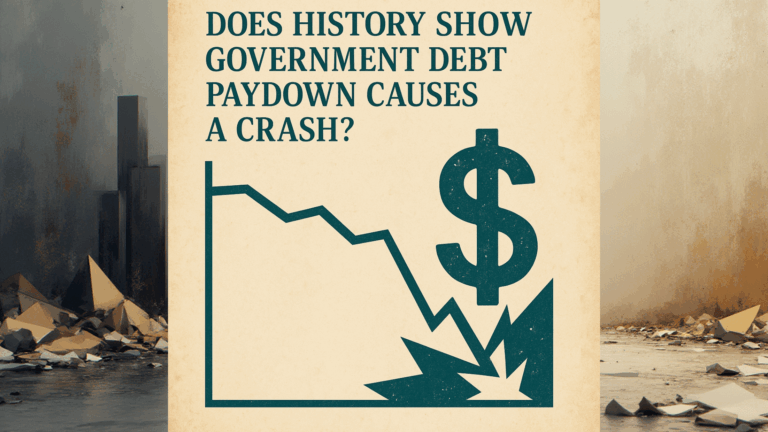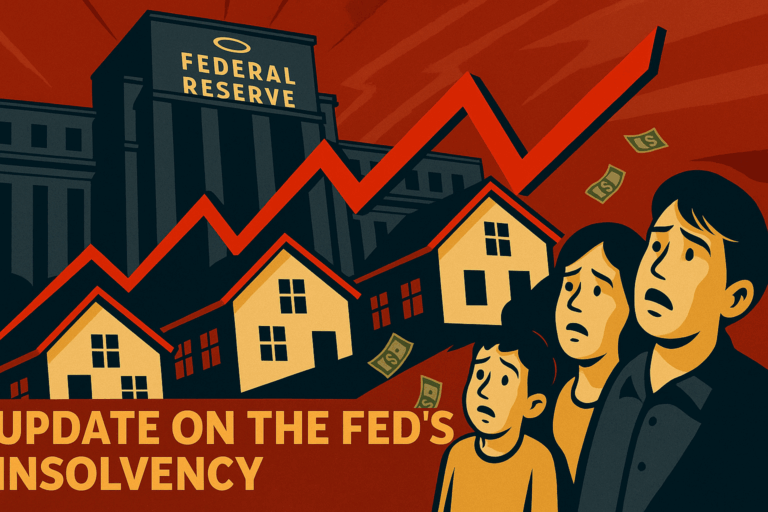Tucker Carlson recently interviewed economist Richard Werner, author of the provocative Princes of the Yen and coiner of the term quantitative easing (QE). One theme of the interview was Werner’s revelation to Tucker—who was clearly surprised to learn—that private banks “create money” in our current financial system, and in fact create the vast majority of it, far more than central banks/governments.
In the discussions on social media after the episode dropped, I saw a familiar pattern: Fans of the “credit creation” view of money & banking advocated for Werner’s (correct) claims in a way that would put the private banks on the same footing as the central bank. And that is going too far. Specifically, when banks “create money” through loan creation, it is by expanding people’s claims on the bank, which do indeed circulate in modern economies at par with lawful money. However, when the Federal Reserve “creates money” through its operations, it expands reserves at the Fed that are legally and economically interchangeable with rectangular green pieces of paper featuring Benjamin Franklin and Andrew Jackson. That’s not something Citibank can do. (It’s why private banks can still get into financial trouble, after all. They can’t “create money” in the same way that the Fed or ECB or Bank of Japan can.)
In order to spell all of these distinctions out, I thought it would be useful to write up the actual double-entry bookkeeping operations that occur when an institution borrows and lends money. First we will examine the operations and related accounting when a conventional, nonbank business (in this case, we’ll use Tesla) does it. Then we’ll examine what happens when a private bank (in this case, Citibank) does it. Because this is so complicated—it matters what the borrower from the bank does with the newly-created money—I will split the discussion up into Parts 1 and 2 of this series. Finally, in Part 3 I will show what happens when the Federal Reserve makes loans and creates money, and how this has important differences from when a mere private commercial bank does so.
Case 1: Tesla, a Non-Bank Institution Acting as Pure Credit Intermediary
Let’s start with the simplest case, where a non-bank institution—we’ll use Tesla—borrows money from a household (Jim Smith), in order to lend those funds to a different borrower. Specifically, suppose Tesla issues a corporate bond for $100,000 today, and will redeem that note for $105,000 in one year’s time. In other words, Tesla is borrowing $100k at 5%.
As soon as the funds settle in Tesla’s checking account, it wires them to a solar panel company, which wants to borrow funds from Tesla for one year, and is willing to pay 8% on the loan.
Then in a year’s time, the solar panel company pays back the $100,000 principal plus $8,000 in interest, and Tesla redeems its outstanding TSLA bond. Tesla is left with an excess $3,000 which is its asset now, free and clear, and boosts the shareholder equity.
The following sequence of T-accounts shows the transactions step by step. For simplicity, I assume that originally Tesla has $1 million in its business checking account and no liabilities, for total original shareholder equity of $1 million. (I included this feature to round out the analysis and avoid “infinite leverage” in Tesla’s deal. Obviously these numbers are for convenience.)
Snapshot 1, September 1, 2025, 12pm: Tesla original position
| Assets | Liabilities + Shareholder Equity |
|---|---|
| Tesla checking account balance: $1,000,000 |
Liabilities: (none) Equity: $1,000,000 |
| Total Assets: $1,000,000 | Total Liabilities + Equity: $1,000,000 |
Snapshot 2, September 1, 2025, 1pm: Tesla borrows $100,000 at 5%
| Assets | Liabilities + Shareholder Equity |
|---|---|
| Tesla checking account balance: $1,100,000 |
Liabilities: TSLA 5% Bond held by Jim Smith: $100,000 Equity: $1,000,000 |
| Total Assets: $1,100,000 | Total Liabilities + Equity: $1,100,000 |
Snapshot 3, September 1, 2025, 2pm: Tesla lends $100,000 at 8%
| Assets | Liabilities + Shareholder Equity |
|---|---|
|
Tesla checking account balance: $1,000,000 PanelsRUS 8% Bond held by Tesla: $100,000 |
Liabilities: TSLA 5% Bond held by Jim Smith: $100,000 Equity: $1,000,000 |
| Total Assets: $1,100,000 | Total Liabilities + Equity: $1,100,000 |
Then a year passes, and the following transactions occur:
Snapshot 4, September 1, 2026, 1pm: PanelsRUS pays Tesla $108,000 to redeem its bond.
| Assets | Liabilities + Shareholder Equity |
|---|---|
| Tesla checking account balance: $1,108,000 |
Liabilities: TSLA 5% Bond held by Jim Smith: $105,000 Equity: $1,003,000 |
| Total Assets: $1,108,000 | Total Liabilities + Equity: $1,108,000 |
Snapshot 5, September 1, 2026, 2pm: Tesla pays Jim Smith $105,000 to redeem its bond.
| Assets | Liabilities + Shareholder Equity |
|---|---|
| Tesla checking account balance: $1,003,000 |
Liabilities: (none) Equity: $1,003,000 |
| Total Assets: $1,003,000 | Total Liabilities + Equity: $1,003,000 |
When the dust settles, Tesla is left with $1,003,000 in its checking account, and no outstanding liabilities. Hence, its shareholder equity went up during the course of the year by $3,000. This makes sense, because of the 3-percentage-point spread on the bond yields, with a principal of $100,000.
To anticipate where we are going in this discussion, let me emphasize something important: In “Snapshot 3,” when Tesla made a loan of $100,000 to PanelsRUS, that transaction did not create money. On the contrary, Tesla’s holdings of cash went down by $100,000, while its bond assets went up by $100,000. The loan Tesla granted did not increase either side of its balance sheet; it simply changed the composition of its assets. And because Tesla’s activity didn’t create money, we can view it in this first case as a pure credit intermediary; it effectively channeled the actual savings of Jim Smith into the hands of the solar company.
As we will see in the next section, these principles do not hold when a commercial bank makes a loan. Understanding the difference in the accounting treatment is the key to really seeing how the rabbit gets into the hat with the “magic” of bank credit money creation.
Case 2: Citi, a Private Commercial Bank that Creates Money Through (Fractional Reserve) Lending
Now suppose we start with Citi, a private-sector company (i.e. not an official vessel of the government) that is a commercial bank. As before, we assume it starts with $1 million in shareholder equity. Yet now, because Citi is itself a bank, we won’t be referring to its “checking account balance,” but instead will refer to vault cash. In other words, when dealing with Tesla, it was fine to treat “money in the bank” as equivalent to “cash,” but when we’re dealing with an actual bank as the company under consideration, it makes more sense to view green pieces of paper—aka Federal Reserve Notes—as “cash.”
Other than that, the basic story is the same: Jim Smith hands over $100,000 of his saved money to Citi, and begins earning 5 percent (which we assume is the yield on his checking account with Citi). Immediately afterward, Citi also advances a loan of $100,000 to the solar company, charging 8%.
Then we jump ahead a year. Jim Smith decides to pull his money out in the form of currency, while PanelsRUS has made enough sales and deposits to replenish its own checking account enough to pay back the loan to Citi. Here are the details:
Snapshot 1, September 1, 2025, 12pm: Citi original position
| Assets | Liabilities + Shareholder Equity |
|---|---|
| Vault cash: $1,000,000 |
Liabilities: (none) Equity: $1,000,000 |
| Total Assets: $1,000,000 | Total Liabilities + Equity: $1,000,000 |
Snapshot 2, September 1, 2025, 1pm: Jim Smith deposits $100,000 of cash into his checking account, which has APY of 5%
| Assets | Liabilities + Shareholder Equity |
|---|---|
| Vault cash: $1,100,000 |
Liabilities: Jim Smith checking account balance: $100,000 Equity: $1,000,000 |
| Total Assets: $1,100,000 | Total Liabilities + Equity: $1,100,000 |
Snapshot 3, September 1, 2025, 2pm: Citi lends $100,000 at 8%
| Assets | Liabilities + Shareholder Equity |
|---|---|
|
Vault cash: $1,100,000 PanelsRUS 8% Bond held by Citi: $100,000 |
Liabilities: Jim Smith checking account balance: $100,000 PanelsRUS checking account balance: $100,000 Equity: $1,000,000 |
| Total Assets: $1,200,000 | Total Liabilities + Equity: $1,200,000 |
Then a year passes, and the following transactions occur:
Snapshot 4, September 1, 2026, 1pm: PanelsRUS pays Citi $108,000 to redeem its bond.
| Assets | Liabilities + Shareholder Equity |
|---|---|
| Vault cash: $1,108,000 |
Liabilities: Jim Smith checking account balance: $105,000 PanelsRUS checking account balance: $0 Equity: $1,003,000 |
| Total Assets: $1,108,000 | Total Liabilities + Equity: $1,108,000 |
Snapshot 5, September 1, 2026, 2pm: Jim Smith withdraws $105,000 from his checking.
| Assets | Liabilities + Shareholder Equity |
|---|---|
| Vault cash: $1,003,000 |
Liabilities: Jim Smith checking account balance: $0 PanelsRUS checking account balance: $0 Equity: $1,003,000 |
| Total Assets: $1,003,000 | Total Liabilities + Equity: $1,003,000 |
This is already a long post, so we will start wrapping things up. Notice that the endpoints are similar: In both scenarios, the institutions engaged in an interest rate spread in order to earn (over the course of the year) a total of $3,000 in income, which is theirs free and clear at the end.
However, there was something qualitatively different in the accounting treatment of the loans each institution made to the solar company. Remember that in Snapshot 3 for Tesla, its balance sheet didn’t increase with the loan; the composition of its assets was simply rearranged.
But for Citi, in Snapshot 3 its total assets went up by the full $100,000 (and so did its liabilities). This is because the pure act of granting the loan to PanelsRUS doesn’t initially show up as funds “taken” from anywhere; Citi simply marks up PanelsRUS’s checking account balance by $100,000. (That’s why Citi’s liabilities went up $100,000.) This is a critical difference between Tesla lending the money, versus Citi lending it.
How Banks “Create Money”
The total stock of money did not go up when Tesla lent the money; it ultimately just took Jim Smith’s money and gave it to PanelsRUS. But things were different with the bank case. Here, Jim Smith didn’t really think he was lending his money to Citi; no, he put it on deposit, and still considered that $100,000 as part of his cash balance. Yet at the moment of granting the loan to PanelsRUS, Citi made the people running the solar company think that they too now had access to an additional $100,000 in money.
This is not mere semantics. Economists have different “monetary aggregates,” and anything from M1 and broader (M2, M3, etc.) contains checking account balances (aka “demand deposits”) as part of “the money supply.” In our second scenario above, when Citi grants the loan, at that moment the total amount of checking account balances in the community went up by $100,000. That is the sense in which bank credit can “create money.”
Having established all of this, we have to be careful and not assume that private commercial banks are as powerful as the government/central bank, as if they had a literal USD printing press at their disposal. There are important steps we glossed over in the analysis above, by simply jumping ahead a year and seeing Citi’s balance sheet when the loan was repaid, etc. In order for Citi to remain viable, it can’t be too aggressive with its lending—it matters what happens after Citi grants that loan. But this is a complicated affair, and we will postpone the explanation until Part 2 of this series.
Dr. Robert P. Murphy is the Chief Economist at infineo, bridging together Whole Life insurance policies and digital blockchain-based issuance.
Twitter: @infineogroup, @BobMurphyEcon
Linkedin: infineo group, Robert Murphy
Youtube: infineo group
To learn more about infineo, please visit the infineo website

